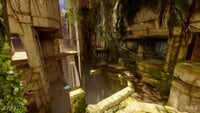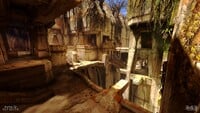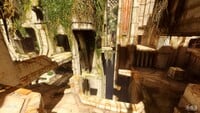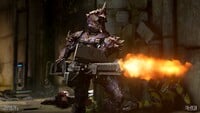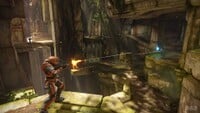Forbidden
From Halopedia, the Halo wiki
| Forbidden | |
|---|---|

| |
| Map overview | |
|
Game: |
|
| Lore information | |
|
Location: |
Ancient temple, Installation 07[1] |
| Gameplay overview | |
|
Terrain: |
Stone ruins, natural terrain[2] |
|
Map layout: |
|
|
Recommended number of players: |
8 |
|
Recommended gametype(s): |
|
Forbidden is a symmetrical multiplayer arena map coming to Halo Infinite with Season 05: Reckoning.[1][2]
Universe and lore
Forbidden is set within a temple on Installation 07. Ancient aqueducts wind through the temple, supplying the lush vegetation on one side of the structure with ample water, while the vegetation on the other side of the temple remains dried-up.[1]
Overview
Layout
Forbidden is a symmetrical map set up for close and medium-range gunfights.[3] To assist players in identifying which side of the map is which, one side features lush green vegetation while the other side's vegetation is dried and dead.[1] Each side of the map features chutes that players can slide through to reach the lower level.[4] Forbidden features long sightlines that players can take advantage of using the SRS99-S7 AM sniper rifles that spawn on each side of the map. The center of the map includes a power equipment spawn.[1]
Callouts
The following are locations on the map that are so named on the player's heads-up display during gameplay:
 This section needs expansion. You can help Halopedia by expanding it.
This section needs expansion. You can help Halopedia by expanding it.
Production notes
- As the design team started to work on Forbidden, they established the aesthetic before even beginning the blockout of the map. With this particular map, they wanted to evoke the architecture of the stone ruins of Installation 05.[1]
- The map was designed primarily for Capture the Flag, though it works with other modes as well. The design team included "rat holes" on either side of the map to allow players some unique movement paths.[4]
Gallery
A Flood-infected Spartan facing down an Unggoy Conscript on the map.
Sources
- ^ a b c d e f g h i j k Halo Waypoint, Maps Overview - Season 5 (Retrieved on Oct 12, 2023) [archive]
- ^ a b YouTube - HALO, Season 5: Reckoning Trailer | Halo Infinite (Retrieved on Oct 9, 2023)
- ^ a b c YouTube - IGN, Halo Infinite Season 5: Reckoning - New Maps, Battle Pass, and Extraction Mode Explained (Retrieved on Oct 9, 2023)
- ^ a b Kotaku, Halo Infinite: Here’s Your First Look At Season 5’s Awesome New Maps (Retrieved on Oct 9, 2023) [archive]
